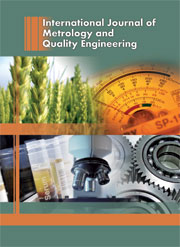Article contents
Absolute optical frequency measurements of iodine-stabilizedHe-Ne laser at 633 nm by using a femtosecond laser frequency comb
Published online by Cambridge University Press: 14 November 2012
Abstract
The optical frequency comb generator (OFCG) is an attractive optical reference source forvarious applications such as optical frequency metrology, precision spectroscopy andtelecommunications [D.J. Jones, S.A. Diddams, J.K. Ranka, A. Stentz, R.S. Windeler, S.T.Cundiff, Science 288, 635–639 (2000); T. Udem, R. Holzwarth, T.W. Hänsch,Nature 416, 233–237 (2002); T.W. Hänsch, J. Alnis, P. Fendel, M. Fischer, C.Gohle, M. Herrmann, R. Holzwarth, N. Kolachevsky, Th. Udem, M. Zimmermann, Philos. Trans.R. Soc. A 363, 2155–2163 (2005)]. In particular, the OFCG can be used assource for absolute frequency measurement, providing a precise ruler for length metrology.In the present work we describe the results of absolute frequency measurements of primarywavelength standards at 633 nm on the sixth components, d, e, f, g, h and i of the R(127)11-5 hyperfine transition of the 127I2 molecule, at the SpanishCentre of Metrology, CEM. The values obtained with a femtosecond frequency comb (FC1500,Menlo Systems) at CEM are compared with the values recommended by the ConsultativeCommittee for Length (CCL) [T.J. Quinn, Metrologia 40, 103–133 (2003)]. Thisdetermination was made by beat frequency method between a femtosecond laser comb and aniodine-stabilized He-Ne laser. The difference between the mean frequency of the sixthcomponents of the standard laser and those of CCL recommended values for the samecomponents was found to be 6.557 kHz.
Information
- Type
- Research Article
- Information
- International Journal of Metrology and Quality Engineering , Volume 3 , Issue 2 , 2012 , pp. 101 - 106
- Copyright
- © EDP Sciences 2012
References
- 7
- Cited by

